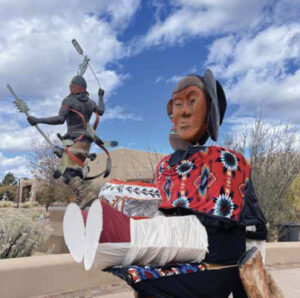Puppets and Pottery: Museum Embraces Institutional Collaborations

The Museum of Indian Arts and Culture has long partnered with other cultural institutions and tribal communities across the Southwest on exhibitions and educational programs.
In a recent collaboration, the museum partnered with the School for Advanced Research on the exhibition Grounded in Clay: The Spirit of Pueblo Pottery, contributing $55,000 in proceeds from the 2021 Native Treasures Art Market to support exhibition costs. The show, which debuted at the museum last July, remains on view through May 29, after which it travels to the Metropolitan Museum in New York and other venues.
The museum’s recently reopened permanent exhibition, Here, Now and Always, is a model for community collaboration. The exhibition positions Indigenous peoples as the preeminent authorities on their own histories and lifeways, “relying heavily on the Native voice in telling the stories,” says curator of ethnology Tony Chavarria (Santa Clara Pueblo).
The renovation of the exhibition, which originally opened in 1997, inspired a unique collaboration with the Institute of American Indian Arts. A group of the school’s performing arts students, under the direction of instructor Sheila Rocha (Tarasco/Pure’pecha), staged a large-scale puppet performance in the museum galleries.
For the eight themed gallery sections—Cycles, Ancestors, Community, Home, Trade and Exchange, Arts, Language and Song, and Survival and Resilience—the students created a host of giant puppets, reinterpreting each section with movement, music and song.
“The performance,” says Lillia McEnaney, the museum’s assistant curator, “activated and enlivened the space with its vibrant storytelling approach.” The performance also took place in the Dance Circle outside of the museum.
“One of the most compelling moments was a student’s portrayal of Po’Pay in the gallery’s Survival and Resilience section,” says the museum’s archivist Diane Bird (Santo Domingo Pueblo), who wrote the monologue portraying the leader of the 1680 Pueblo Revolt.
Bird’s portrayal includes this powerful passage: “The Spaniards called us ‘vassals of the king of Spain’ and when they tried to rule, enslave and kill us as if we were mere chattel, we rose up against them... at this moment in history, our successful revolt reclaimed our destiny as autonomous human beings.”
According to Rocha, puppetry is important in Indigenous cultures. The Institute of American Indian Arts is one of a handful of universities nationwide that offers courses in the construction and use of large-scale puppetry.
“The magic of animating inanimate objects to tell a story takes an audience into a realm of ancient memory,” Rocha says. “Indigenous societies have always performed stories and used performance to actualize ceremony and rituals.” The puppet performance was sponsored by Museum of New Mexico Foundation Honorary Trustee Eileen Wells, who says she was “thrilled to support this important collaboration between these talented IAIA students and the MIAC curators.” Additional support for the Here, Now and Always reopening was received from the Family of Marie and Tony Hillerman and the National Endowment for the Humanities.
Moving forward, museum staff is exploring future partnerships for Here, Now and Always and other museum exhibitions.
Bringing such partnerships to fruition will require private funding via the Museum of New Mexico Foundation. To support the Museum of Indian Arts and Culture, contact Lauren Paige at 505.982.2282 or Lauren@museumfoundation.org.
This article and image are from the Museum of New Mexico Foundation’s Member News Spring 2023.


Connect